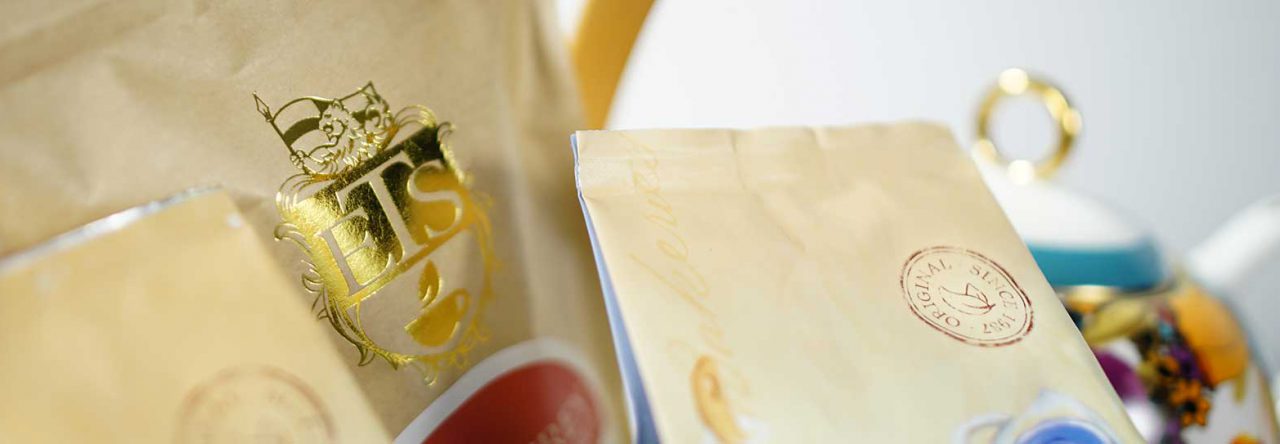
Transferware revolutionized teaware designs. Teawares and decorations go together like tea and cookies. Hand-painting teacups and teapots had been popular for centuries. But they were slow to make and had to be limited in detail.
Where It Started
As tea in Europe became more popular, the demand for fancier teawares grew. Famed potter John Sadler (see my article about Sadler collectibles) and his associate Guy Green developed a method in 1756 for transferring more detailed images onto teapots, teacups, and other china wares. They claimed that their method could “without the aid or assistance of any other person or persons, within the space of six hours, print upwards of 1,200 earthenware tiles of different patterns, which were more in number, and better, and neater than 100 skillful pot painters could have painted in the like space of time in the common and usual way of painting with a pencil.”
The Method
An engraver skillfully etches a copper plate with the design. Printers ink is rubbed across the entire surface and the excess wiped off, leaving ink only in the etched parts. A sheet of paper is laid on the plate and pressed to pick up the ink from the etched parts. Then that same sheet is laid face down on the dish. Here is where a bit of experience is needed. Getting the paper positioned properly on something shaped like a dinner plate is relatively simple but on a gravy boat, coffeepot or teapot is another matter. Once in position, the paper is rubbed to transfer the ink to the dish. Once the ink is dry, the dish is placed in a kiln to burn out any excess. Finally, the dish is glazed and fired again in the kiln, giving the piece a shine.
The secret of this method didn’t stay secret long, and transferware, as it came to be known, became the dominant type of dinnerware. This peaked between 1815 and 1835, with transfer prints being at their height of creativity and quality. The U.S. market for these wares exploded with tons of transferware being produced in England and imported for sale there. This was the revolution. Now, complex patterns and images could be reproduced by the thousands relatively quickly and therefore much more affordably.

Blue Willow, one of the best known transferware patterns, was introduced in the 1790s by Johnson Brothers. My mother grew up eating off of this pattern dishware and so bought a set when she could afford to (we still young children). I grew up with that pattern, picking at the foods I didn’t like and pushing them from one part of the design to another, and gobbling the foods I did like. When grandma died, her set went to my mother, who then had two complete sets plus extra pieces added through the years. We had a lot of very fine meals on those dishes. And yes, the combined super set contained two teapots, two coffeepots, two cream and sugar sets, and at least a dozen teacups and saucers.
Other transferware patterns ranged in subject matter from bucolic scenes to those inspired by Asian, Greek, and Roman cultures, and scenes around England.
Most experts say to hand wash these pieces with a gentle detergent, but you can place them in the dishwasher if each piece is placed far enough apart that it doesn’t touch any other piece during the various cycles.

Collecting
Transferware has been mass produced since the mid-18th century, so you will find thousands of pieces available for sale online. If you want to collect it, my best recommendation is that you become a member of Transferware Collectors Club. They will help you weed out the so-so pieces from the truly good ones.
Blue on white, red on white, and brown on white are the most common colors, but today’s collectors mainly go for the two-tone patterns. You will rarely see pieces made from the 1750s through the late 1800s for sale anywhere. If you do, be sure to check it out thoroughly. Most of the pieces you will find for sale are those made during the 20th century which will be less valuable but equally appealing.
Rare pieces are those that are “flubbed” during the application of the pattern to the dish. Changes in design are also something to look for. In Blue Willow, for example, some have three men on the bridge and others have only two. The set we had contained a mix of both.
If you choose to seek out transferware, here’s wishing you much success. First and foremost, buy those pieces you like. Cheers!
See more of A.C. Cargill’s articles here.
© Online Stores, Inc., and The English Tea Store Blog, 2009-2014. Unauthorized use and/or duplication of this material without express and written permission from this article’s author and/or the blog’s owner is strictly prohibited. Excerpts and links may be used, provided that full and clear credit is given to Online Stores, Inc., and The English Tea Store Blog with appropriate and specific direction to the original content.



Leave a comment